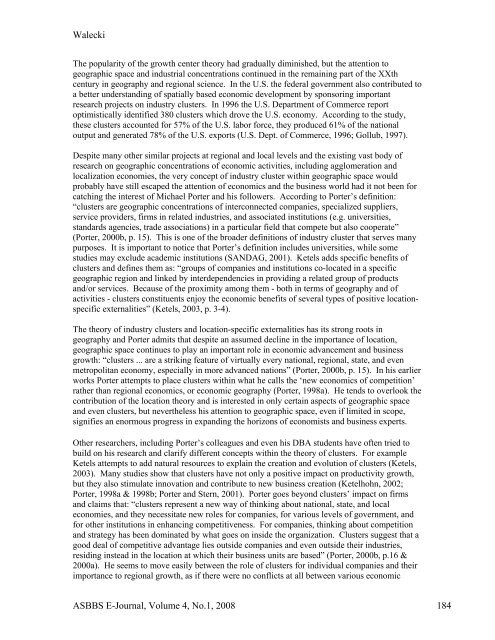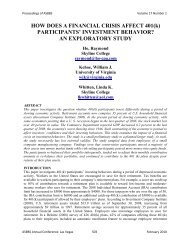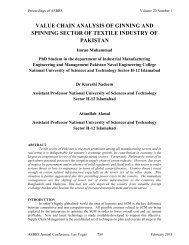stock repurchase announcements: a test of market ... - Asbbs.org
stock repurchase announcements: a test of market ... - Asbbs.org
stock repurchase announcements: a test of market ... - Asbbs.org
You also want an ePaper? Increase the reach of your titles
YUMPU automatically turns print PDFs into web optimized ePapers that Google loves.
Walecki<br />
The popularity <strong>of</strong> the growth center theory had gradually diminished, but the attention to<br />
geographic space and industrial concentrations continued in the remaining part <strong>of</strong> the XXth<br />
century in geography and regional science. In the U.S. the federal government also contributed to<br />
a better understanding <strong>of</strong> spatially based economic development by sponsoring important<br />
research projects on industry clusters. In 1996 the U.S. Department <strong>of</strong> Commerce report<br />
optimistically identified 380 clusters which drove the U.S. economy. According to the study,<br />
these clusters accounted for 57% <strong>of</strong> the U.S. labor force, they produced 61% <strong>of</strong> the national<br />
output and generated 78% <strong>of</strong> the U.S. exports (U.S. Dept. <strong>of</strong> Commerce, 1996; Gollub, 1997).<br />
Despite many other similar projects at regional and local levels and the existing vast body <strong>of</strong><br />
research on geographic concentrations <strong>of</strong> economic activities, including agglomeration and<br />
localization economies, the very concept <strong>of</strong> industry cluster within geographic space would<br />
probably have still escaped the attention <strong>of</strong> economics and the business world had it not been for<br />
catching the interest <strong>of</strong> Michael Porter and his followers. According to Porter’s definition:<br />
“clusters are geographic concentrations <strong>of</strong> interconnected companies, specialized suppliers,<br />
service providers, firms in related industries, and associated institutions (e.g. universities,<br />
standards agencies, trade associations) in a particular field that compete but also cooperate”<br />
(Porter, 2000b, p. 15). This is one <strong>of</strong> the broader definitions <strong>of</strong> industry cluster that serves many<br />
purposes. It is important to notice that Porter’s definition includes universities, while some<br />
studies may exclude academic institutions (SANDAG, 2001). Ketels adds specific benefits <strong>of</strong><br />
clusters and defines them as: “groups <strong>of</strong> companies and institutions co-located in a specific<br />
geographic region and linked by interdependencies in providing a related group <strong>of</strong> products<br />
and/or services. Because <strong>of</strong> the proximity among them - both in terms <strong>of</strong> geography and <strong>of</strong><br />
activities - clusters constituents enjoy the economic benefits <strong>of</strong> several types <strong>of</strong> positive locationspecific<br />
externalities” (Ketels, 2003, p. 3-4).<br />
The theory <strong>of</strong> industry clusters and location-specific externalities has its strong roots in<br />
geography and Porter admits that despite an assumed decline in the importance <strong>of</strong> location,<br />
geographic space continues to play an important role in economic advancement and business<br />
growth: “clusters ... are a striking feature <strong>of</strong> virtually every national, regional, state, and even<br />
metropolitan economy, especially in more advanced nations” (Porter, 2000b, p. 15). In his earlier<br />
works Porter attempts to place clusters within what he calls the ‘new economics <strong>of</strong> competition’<br />
rather than regional economics, or economic geography (Porter, 1998a). He tends to overlook the<br />
contribution <strong>of</strong> the location theory and is interested in only certain aspects <strong>of</strong> geographic space<br />
and even clusters, but nevertheless his attention to geographic space, even if limited in scope,<br />
signifies an enormous progress in expanding the horizons <strong>of</strong> economists and business experts.<br />
Other researchers, including Porter’s colleagues and even his DBA students have <strong>of</strong>ten tried to<br />
build on his research and clarify different concepts within the theory <strong>of</strong> clusters. For example<br />
Ketels attempts to add natural resources to explain the creation and evolution <strong>of</strong> clusters (Ketels,<br />
2003). Many studies show that clusters have not only a positive impact on productivity growth,<br />
but they also stimulate innovation and contribute to new business creation (Ketelhohn, 2002;<br />
Porter, 1998a & 1998b; Porter and Stern, 2001). Porter goes beyond clusters’ impact on firms<br />
and claims that: “clusters represent a new way <strong>of</strong> thinking about national, state, and local<br />
economies, and they necessitate new roles for companies, for various levels <strong>of</strong> government, and<br />
for other institutions in enhancing competitiveness. For companies, thinking about competition<br />
and strategy has been dominated by what goes on inside the <strong>org</strong>anization. Clusters suggest that a<br />
good deal <strong>of</strong> competitive advantage lies outside companies and even outside their industries,<br />
residing instead in the location at which their business units are based” (Porter, 2000b, p.16 &<br />
2000a). He seems to move easily between the role <strong>of</strong> clusters for individual companies and their<br />
importance to regional growth, as if there were no conflicts at all between various economic<br />
ASBBS E-Journal, Volume 4, No.1, 2008 184

















